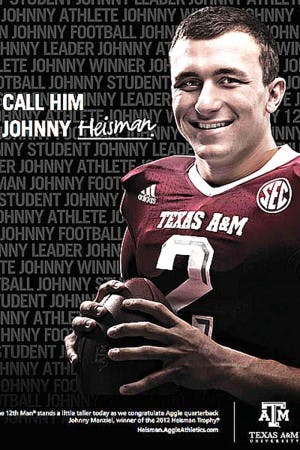Last Saturday night, freshman Johnny Manziel won the Heisman Trophy just two years after only two Division 1 schools showed real interest in him as a quarterback.
Yes, only two — Texas A&M and Rice. He was just too small to be a successful, big-time college quarterback. Or so they thought.
And, for those who think that this was a one-off, one-time occurrence, perhaps you’ve heard of Robert Griffin III? He won the Heisman Trophy last year at Baylor and is the rookie starting quarterback for the Washington Redskins after being selected second in the NFL draft. Most didn’t see him as the typical college quarterback either.
The last two Heisman winners were largely unnoticed by the experts. If people who spend their careers looking at tape, reviewing stats and analyzing future success can miss this kind of potential – it must not be easy.
How do you know potential?
Potential is mysterious even though we can act otherwise. “We just don’t see her as leadership material.” “He has the potential to move up to a VP one day.” “She’s a superstar – one of our high potentials.” How do you know for sure?
The truth is, you don’t. You may be closer to the Ouija board and a fortune teller than the predictable metrics and plans we know and love. Potential is a small dose of science, with lots of art.
Defining potential should affect where you choose to invest. Those with potential often receive special attention. They may benefit from a special leadership development program or plum assignments. Potential should matter to your business or don’t bother trying to predict it.
Let’s see if we can close the gap. Here are some signs you are only one step beyond the Ouija board.
Signs you aren’t measuring potential
- Potential is undefined. There is no clear definition – you just follow your gut.
- Potential is really performance. You can have a “meets expectations” performer with high potential. The newly promoted manager or the accountant you moved to Marketing (to broaden his skills) may each have performance that is far from exceptional. Likewise, a manager may be a top performer, but not have the ability to move up to Director, much less VP – no matter how much time is allowed.
- Potential is based on today. If you have seen the top seller become the manager of the sales team and fail – you understand. Just because someone excels in a role today, everyone assumes they will be even better at the next level up. Simply not true.
How can you quantify potential and make it more predictable? Is it even possible? It is clearly more art than science, but there are some actions that can increase your “potential predictor.”
Actions to help determine potential
- Have a clear definition. Sounds basic, but have a simple definition of potential so that you have a common language and the indicators that you will consider. Some organizations focus on specific competency ratings, leadership success or conceptual abilities. Agree what works for you and apply it to all candidates as your first filter.
- Consider tomorrow’s business and talent needs. If your business is going global, adding new services or centralizing, the business will need new leadership capabilities tomorrow that may not be as important today. Consider potential in terms of tomorrow’s expectations, not today’s. This issue certainly caused RGIII and Manziel to be overlooked.
- Use an assessment as input. Some assessments provide input on how individual habits, behaviors and work style will translate to more senior roles. While I don’t believe assessments should be the final determinant, I do think they can serve as useful input.
- Structure leadership discussions. A common approach for the potential discussion and criteria helps contrast and compare candidates. This discipline can help you stay in the analytical art zone rather than free form.
- Remember the art of it. The truth is assessing potential requires judgment, insight and an ability to project the future. Make sure you have a place for thoughtful observations and insights that won’t show up elsewhere. An example is the manager who always raises her hand, is admired by her team and brings innovation wherever she goes and there is a feeling that her strengths will only multiply in the future.
Manziel and RG III were missed by football experts because they didn’t fit the established prototype. And, because the X factor they had was disregarded, overlooked or even missed.
I think their lesson is have a process, do your homework and quantify whatever you can, but consider the human being and how they play, think and lead. Information that you can’t get from a rating, report or analysis may be the difference maker after all.
This was originally published on PeopleResult’s Current blog.
